Future Expansion
There are plenty of candidates for future additions to the spacecraft simulated in Project Apollo after the basic historical Command/Service Module and Lunar Module are complete.
Command/Service Module
Support may be added for the proposed Block-III CSM with batteries for power in place of fuel cells, and the Block-IV CSM with batteries for power and LEM engines in place of the SPS.
In addition, the inclusion of a Block-I CSM in future versions has been discussed.
Apollo to Venus
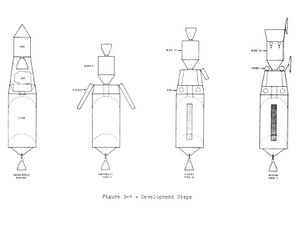
Phase B of the Apollo to Venus plan called for the addition of solar panels to the 'wet workshop' and the use of a Block III CSM so that the astronauts would fly the SIVB into a high altitude orbit for a year-long mission in preparation for an actual fly-by.
Phase C of the Apollo to Venus plan would use an improved version of the 'wet workshop' SIVB with a Block-IV CSM to perform the actual Venus flyby.
Wikipedia has some more information.
Long-Range Flyer/Lunar Escape System
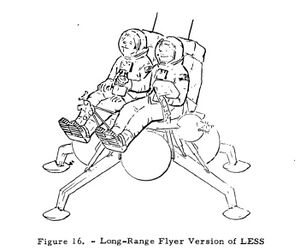
Simple two-man rocket using fuel from the LEM. This could be used for scouting missions to sites up to around 50 miles from the main landing site, or, in an emergency, to carry two astronauts from the lunar surface to rendevouz with the CSM.
The Lunar Escape System was a simpler folding rocket which would be carried in the descent stage of the LM to allow the astronauts to fly into an orbit where the CM Pilot could recover them in the event that the ascent stage failed to fire.
Lunar Motorbike
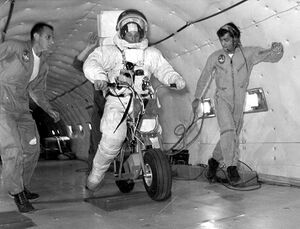
Tentatively planned for Apollo 20.
Original Saturn plans
The original Saturn-A, -B, -C and Nova designs, possibly including the earlier lunar landing plans based on multiple launches, or the single launch putting the entire CSM onto the Moon using the massive Saturn C-8 booster.
For more information see, for example, Saturn-C family and Nova family at Astronautix.com.
Project Able LEM
A plan to use a mirror in space to light up parts of the Vietnam jungle at night. A modified LEM with a huge flexible mirror attached would be launched into space where the mirror would unfold.
A similar plan proposed using a modified LEM to fly to Soviet satellites and spray paint over their sensors: effectively the first space vandals.
Project Icarus
Proposal to divert or destroy an incoming asteroid by launching 100 Megaton nuclear bombs on Saturn Vs.
Saturn 1
The Saturn 1 was the precursor to the Saturn 1b, using an SIV stage in place of the SIVB. The SIV was smaller, with a lower fuel capacity, and used multiple RL10 engines in place of the J2 engine on the SIVB.
Saturn 1b MLV
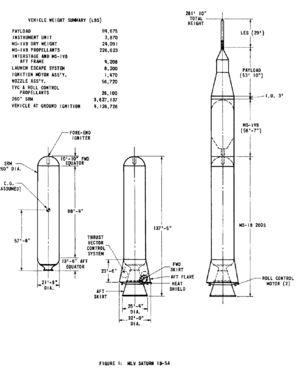
As part of NASA's cost-cutting plans, they studied a 'Modified Launch Vehicle' (MLV) derivative of the Saturn 1b which would replace the S1B stage with a solid rocket similar in size to a shuttle SRB. In essence this was a 1960s version of NASA's new 'Stick' launcher for the CEV.
Saturn 1b with multiple SRBs
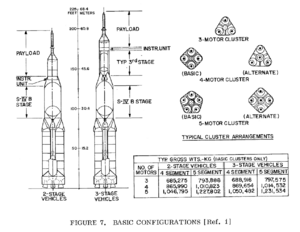
Other Saturn 1b proposals would replace the S1B stage with multiple SRBs, or simply attach SRBs to the side of the S1B stage for extra thrust: that would increase payload rather then reduce cost.
Saturn INT-21
Two-stage launcher used to launch large payloads into Earth orbit. This was used for the Skylab mission.
Saturn S-ID stage
A modified S1C stage which dropped the outer four engines in a similar manner to the Altas dropping two of its engines during launch. As well as multi-stage launchers with greater payloads, it could carry 50,000 pounds to low orbit itself with no second stage.
Saturn V-24
Saturn V with stretched stages, new toriodal aerospike engines on the upper stages, uprated F-1 engines on the first stage, and four strap-on boosters with two F-1 engines each. Capable of putting over 500,000 pounds of payload into low Earth orbit.
Skylab
The NASSP 5.x Skylab sources were lost, so a new version will be required once the INT-21 support is added.
Lunex Project
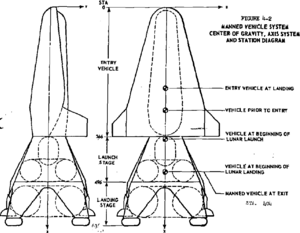
The Lunex Project was a proposed US Air Force alternative to Apollo, which would use a lifting-body re-entry vehicle and land the entire spacecraft stack on the Moon rather than having a separate lander which rendezvoused with the orbiting return craft.
References
Here are a selection of documents with information on these spacecraft, both historical and planned:
- Space Systems Division, Air Force Systems Command, Lunar Expedition Plan, May 1961
- J.O. Mazenauer, Lunar Escape Systems (LESS) Feasibility Study - Summary Report, June 1970
- J.O. Mazenauer, Lunar Escape Systems (LESS) Feasibility Study - Final Technical Report, September 1970
- George J. Hurt Jr, David B. Middleton, and Marion A. Wise, Development Of A Simulator For Studying Simplified Lunar Escape Systems, April 1971
- David B. Middleton and George J. Hurt Jr, A Simulation Study Of Emergency Lunar Escape To Orbit Usnig Several Simplified Manual Guidance And Control Techniques, October 1971
- Manned Venus Flyby study, Feb. 1, 1967
- Final Report - Studies of Improved Saturn V Vehicles and Intermediate Payload Vehicles, October 7th 1966
- Orbital Payload Potential: Saturn 1B Earth Launch Vehicle Using Solid Propellant Motors, September 1964
- Implementing Dock Launch of MLV Saturn 1B-5A, December 1966
- Saturn Improvement Studies: A Summary
- Modified Launch Vehicle MLV Saturn V Improvement Study Composite Summary Report
- Apollo Systems Description: Saturn Launch Vehicles
- Saturn Illustrated Chronology
- Apollo/Saturn C-1 Launch Vehicle System
- Description of a Saturn C-3 and Nova Vehicle
- Saturn I Summary